About Snap and Cubes
Of all the digital card games, Marvel Snap is certainly one of the most unique ever released, both regarding deckbuilding and game mechanics. To climb in the ranked ladder, you need to get cubes.
Each match begins with one cube on the line, and all matches have 6 turns (with a few exceptions). And if the match goes to the last round, cubes are doubled in value.
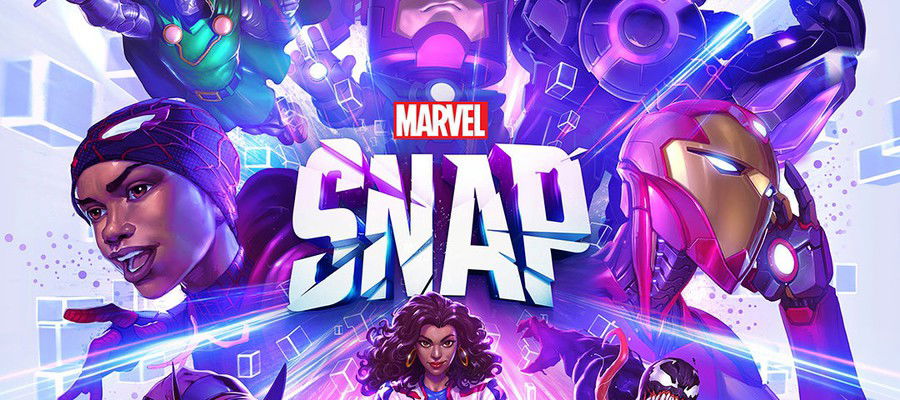
Marvel Snap's magic is in the name itself, Snap! If you press the cube button, you "snap", and the cube value doubles. But remember, if your opponent snaps back, the value doubles again! So, a few matches can be worth up to 8 cubes. At every win, you bring home the number of cubes that are represented in the match, and in case you lose, you will also lose that same number of cubes. Simple, isn't it?
Because of this mechanic, Marvel Snap decks, to be considered good, need a good win rate, alongside a "cubes per match" rate that's even better. Not always the deck with the highest win rate will be the most recommended deck for you to climb the ladder quickly. A deck with a high cubes per match rate can be the best decision for you to boost your rank.
So, I decided to help those who dream about reaching the infamous "infinite" rank, and I gathered in this article 5 lists with the highest cubes per match rate, so you can climb ranks as fast as possible in Marvel Snap!
Analyzing Win Rates
But before we begin, I'll teach you how to analyze win and cubes per match rates, so you can better understand this article.
Let's assume a normal deck has a 50% win rate. It is expected of this same list to have an average of 0.500 cubes per match. You can identify a deck is strong when its cube average, when multiplied by 100, is bigger than its win rate.
For instance: a deck with a 55% win rate, but with an average of 0,573 cubes per match is a great deck. The math goes 0,573x100>55. Got it?
Well, now that you're an expert at reading deck statistics, let's get to the point.
Decks
Kazar — Armor
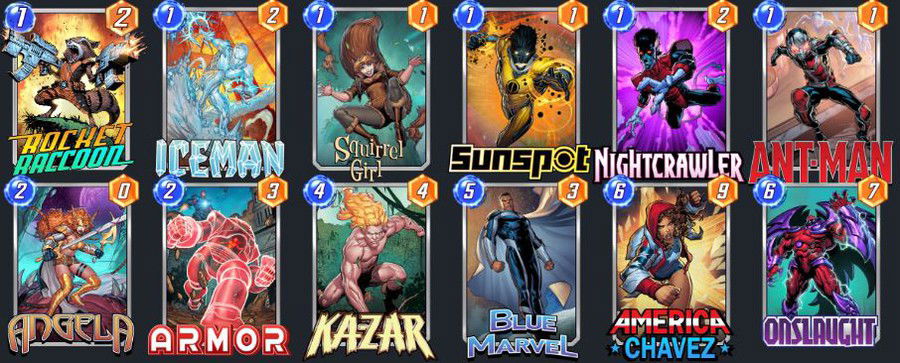
We already started out with a spark! Kazar — Armor. This deck is considered a cheap list as it only has Pool 1 and Pool 2 cards. This way, early on, players can have full access to this deck. And you be certain: many people go far with this list. Kazar — Armor is responsible, many times, for those "First time in Infinite rank!" posts people share in social media. Let's understand why this deck is so strong.
It all comes down to the flexibility this list has regarding its own positioning on board. Cards such as Nightcrawler and Squirrel Girl will help you position units where you normally aren't able to. By having at your disposal low-cost cards early on, very quickly you can dominate locations before your opponent does and leave them with little to no option besides trying to win on another location.
All Kazar archetypes are very popular for those just starting out, and it's still at Pool 1 and 2. As 1 cost cards are very popular in these decks, the majority of players who prefer not playing Kazar opt to use Killmonger.
Certainly, this is Pool 2 players' most hated card. That's where Armor comes along. It will protect your key cards such as Ant-Man and Sunspot. This way, you don't have to worry about losing a good portion of your board to Killmonger.
This deck currently has a 59,46% win rate, and a 0,653 average of cubes per match. And it is the best option for those who are just starting out.
Tips:
— Always try to play your 1 cost cards in the same place you've played your Armor.
— You'll usually have more results by playing Kazar and Blue Marvel in the same location you've played Angela.
— Depending on the match, it's best not to play Kazar and Blue Marvel in the same location, as you risk getting hit with an Enchantress.
— Usually the best strategy is to dominate a location early on, then position Kazar and Blue Marvel in another, and finish with America Chavez.
— Sunspot is one of the best cards in the game. But it might be hard to use in this list. If you're having trouble with it in this deck, you can opt to exchange it for Elektra or Korg
— A very common play with this list is to not do anything in the first turn, in the second play Angela, and then in the third play Nightcrawler in her location. This way, you can afterward clear up space in this location for your "Ongoing" effect cards.
Patriot
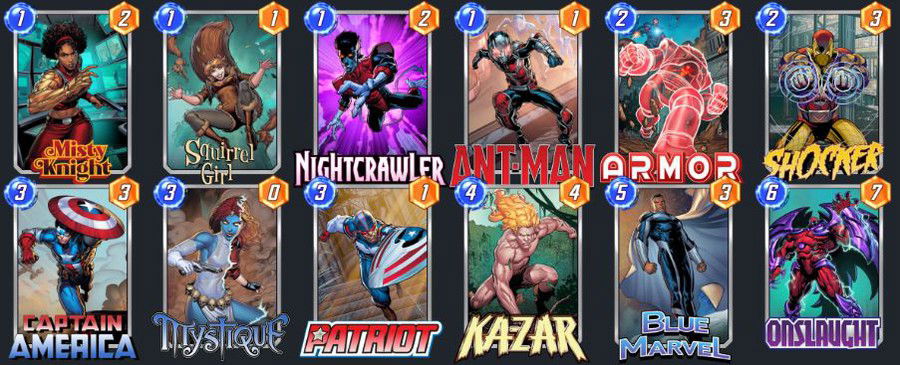
You must be asking yourself... "Wait, this deck looks a lot like Kazar — Armor". And you're right. This list is an upgrade of the deck you've just seen, using Pool 3 cards. And if the first one was already strong, you can already start imagining how this one is too.
The coolest part is that these two decks play in entirely different ways. This version is more focused on using Patriot and the synergy it has with cards without abilities. When you're still at Pool 2, these cards without abilities are almost unplayable. But at Pool 3, they become unstoppable.
It's incredible the number of points you can get with this deck. The only card that prevents your strategy is Enchantress. This card will certainly appear in your nightmares. Other than that, you'll have very few problems understanding this list, and will win many, many cubes.
Its main strategy is to have very active early game turns, and from turn 3 and 4 onward start to position your key cards. In this deck in particular, you have 4 cards that will guarantee you victory: Patriot, Kazar, Blue Marvel, and Onslaught.
Not always you'll draw them all in the match, and it's also not always good to have all of them at your disposal. You need to invest your mana in a smart way in the first few turns, spreading your units across the board. This way, in the last turns, you won't worry about having just a few units that synergize with your Ongoing effects.
This deck is sitting at an amazing 60,16% win rate with an average of 0,672 cubes per match. Certainly, it is one of the most consistent lists in the meta.
Tips:
— Try to use as much as you can Mystique's effect, copying Patriot's effect.
— Many times it is even better to not invest your mana in an Armor. If you notice that the enemy deck doesn't have ways of destroying your units, Armor can delay their development in the first few turns. And it is a card that doesn't have as much synergy with the deck's finishers as well.
— Squirrel Girl is your strongest 1 cost card. The issue is that sometimes it consumes a very important spot in the location you'll play your Onslaught, so keep an eye out for that.
— With time, you'll realize that Captain America is a bit too situational. It works well when you don't draw the most expensive cards in your deck, but usually, you'll prefer to play a Kazar or a Blue Marvel over this card. If it's not performing well for you, you can trade it out for a Cosmo.
— Keep an eye out for Enchantress; sometimes alternating the locations of your Ongoing effects can save you a few cubes.
Good Cards
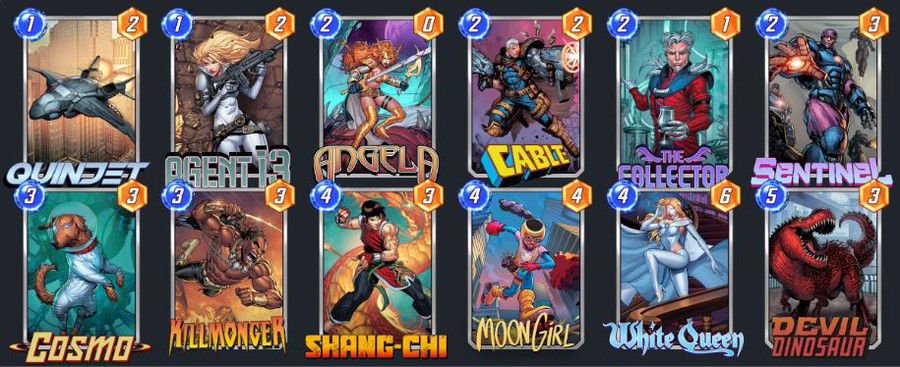
Another very cheap and effective list. In the picture, Quinjet is present, a Pool 3 card. If you're transitioning from Pool 2 to 3, and you get this card early on, congratulations, you have one of the best decks in the game in hands!
But if you don't have it, you can trade it out for these cards:

Of all the game's archetypes, this is certainly the most popular one. Everyone loves Devil Dinosaur, and lately, one of its archetypes started adopting a quite curious name, which is "Good Cards".
As the name already says, the list is a pile of, statistically, the best cards regarding their mana value to the power and effect they deliver on board ratio. That is, every tun you're putting a lot of point pressure against your opponent, and most times they can't do anything about it.
This deck's greatest strength comes from the random creation of cards in your hand. It might be that, in a match, some of the created cards is the one responsible for your victory. In others, it might be that you don't eve care about the randomly generated cards, as long as you have a Devil Dinosaur in hand. This deck is also very flexible and also has control elements such as Shang-Chi, Cosmo and Killmonger.
It is a very strong and fun list. No game is the same every time. Most times you have to think outside the box a bit to get your cubes.
Yeah, it's not a very easy list. Even more so because a great portion of the Meta adapts itself to deal with it, as it is the most popular one. Even so, in good hands, the Devil Dinosaur deck is unstoppable.
This list has a 58,76% win rate, and an average of 0,636 cubes per match.
Tips:
— Early on, place your The Collector in a safe location, so it can scale throughout the match.
— Don't be afraid of playing your Sentinel over and over again. But be careful not to exceed the maximum of 7 cards in hand.
— The most classic line of play with this list is Moon Girl at turn 4, Devil Dinosaur at turn 5, and it again at turn 6. But be careful, as it only works if your Devil Dinosaur is one of the two cards to your further left (and in rare cases it works if it's the third card in your hand, but that only happens if you only have 3 cards total).
— Most times, the White Queen is your best 4 mana card. Besides it placing 6 points on board, it has great synergy with your Devil Dinosaur, and will give you information regarding the enemy deck.
— Never forget that this whole meta is either someone playing Devil Dinosaur or someone trying to win against it. As a result, be very careful about your cards' positioning and if you think it's necessary, trade out your Angela for an Armor, to protect your Devil Dinosaur.
Surfer Sera
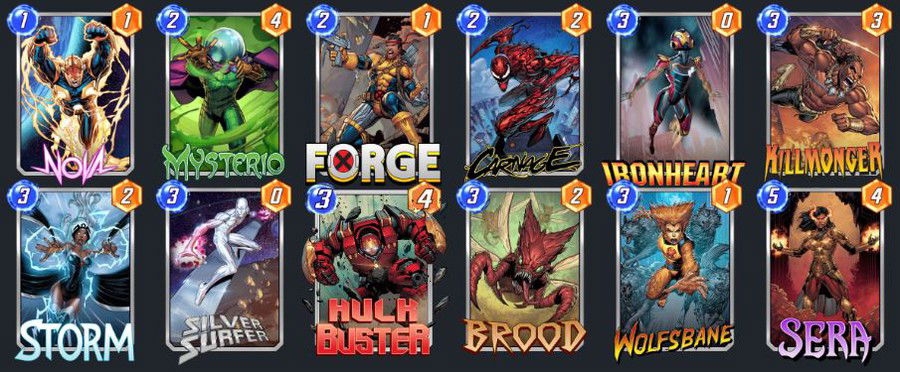
Now we're starting to go into the most advanced decks. This list is filled with very strong tricks and combos. These small combos are so unexpected that, sometimes, it is hard to prepare something to counter them.
Sera has always been very dominant in Marvel Snap's meta, even after nerfs. This card has a game mechanic in which it discounts your cards' costs by 1 mana. This way, if it goes in at turn 5, your turn 6 is boosted.
This deck basically is dunked on in all rounds up to turn 5, and then out of nowhere it fills the board with many different cards and out of the box effects. Certainly, Sera's enemies are tired of being left drooling after witnessing what this deck can do late game.
Its goal is to very early on find some location to flood with your Storm and then play a combo of cards in that same location. Then it's done, you've won a location and only need to worry about the other 2! Depending on how you draw your cards, the way you'll approach your combos will be very different. This deck is very hard to pilot because of that; it forces you to be creative with what you have in hand. Many times you won't even draw Sera, and you'll be forced to make do with what's available.
This list's main weakness is the randomness that hit the locations in your match. This deck usually loses to the board, instead of losing to the enemy deck, as Sera's list doesn't have many ways of protecting their units, and also of manipulating locations. You are welcome to replace Hulk Buster with a Scarlet Witch in case you're losing to many bad locations. Other than that, you won't have many issues against enemy lists.
This deck has a 58,63% win rate and a 0,626 cubes per match average. It is considered the strongest list in higher ranks, and if you have all the cards to craft it, it's worth giving it a shot.
Tips:
— Try to always have 3 units or more on board before playing your Ironheart, but if that isn't possible, don't worry about playing it without taking full advantage of the card's potential. The important part is to have 3 cost units on board so your Silver Surfer can share points at the end of the match.
— Cards such as Nova, Killmonger and Silver Surfer are best if used turn 6.
— Carnage is there to free up space on board. But it is a very situational card, and most times it's best to not use it. If you need to play Carnage, prepare the location you'll play him in a way that it only has units with 2 power points or below.
— Forge will be the one responsible for your early game combos. It has synergy with The Brood, Hulk Buster and Storm.
— Wolfsbane and Killmonger are more situational cards. If there are any locations on spotlight during the week, don't hesitate in trading out these two cards to adapt to the new location. If you also feel like both are not performing that well, you can trade them for Juggernaut, Polaris or even Maximus.
— Silver Surfer is your great finisher. As a result, be sure it will always be the last card to be revealed on the board.
Wong
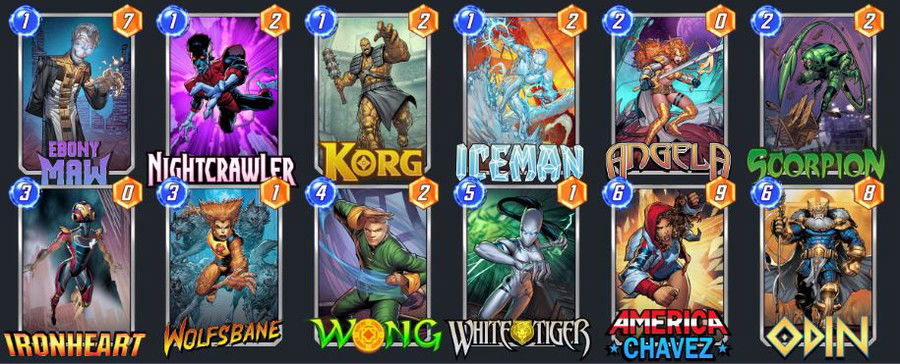
Did you think I had forgotten him? The boogeyman of players that are transitioning from Pool 2 to Pool 3, Wong!
The "On Reveal" archetype is very used in the first Pools, but it gets even stronger when you go into Pool 3, and you're presented with Wong early on. There's no secret; in this list, a great portion of the cards are very self-sufficient, and have great synergy with Odin and Wong. You have the classic early game starter with Ice Man, Korg and Scorpion. These three cards, if played in the first few turns, already will make your opponent want to flee. This list has mobility with Nightcrawler, and a very strong combo with White Tiger and Wong.
Be careful, as this list could be even more powerful, if it didn't lose miserably to Cosmo. This doggy is a very dominant card in the Meta. So, be prepared and pay attention to who reveals cards first. It is very easy to identify: just check which player name is shining, and the one which is, gets to reveal first.
Usually, control decks like to reveal last, but Cosmo is better when revealed first, even though it is a control card. If it weren't for this card, you can be sure Odin and Wong lists would be even stronger.
But if you don't have Wong, don't worry, as though it is a very important card, this monk doesn't define the archetype alone. And you can trade it for various cards, such as all of the below:

This deck has a 60,88% win rate. And it has an amazing average of 0,712 cubes per match! The biggest average so far. This is a result of, many times, even though you get hit with a Cosmo in the same place your Wong is, you can still win.
Tips:
— Don't be afraid of playing your Ebony Maw early on. Your deck can easily fill spaces on board with White Tiger's Tiger Spirits.
— Avoid playing in different locations early on, and try to always guarantee victory in one place alone. Let White Tiger do its work after turn 5.
— At Turn 4, Wong will always be the target of enemy removals. A way of preventing it to be countered is playing this monk in a location which is completely filled by your opponent.
— Usually, the location in which you place Wong is the one you lose. But in some cases it is good to invest in a Wolfsbane in this same location, to surprise your opponent.
— Don't underestimate the power that Korg's Rocks have of delaying your opponent's deck. Try to look for this card as soon as possible.
— If the locations in the match provide you with a lot of mana early on, don't hesitate to combo Scorpion with Wong. -2 power to all enemy cards is quite an advantage.
— Sometimes, Odin will not be that necessary. As a result, America Chavez works very well in this deck. Sometimes you only need those 9 points in that specific location.
— America Chavez is useful to give you more consistency with this list. You'll soon realize that, with it in your deck, a lot of your matches will be the same. That's good for those trying to climb fast, but a bit boring for those who want to have fun.
Final Thoughts
If you've read so far, congratulations, now you have all the knowledge required to win lots of cubes and boost your rank!
If you liked this article and would like to read more about Marvel Snap, don't forget to share and comment down below.
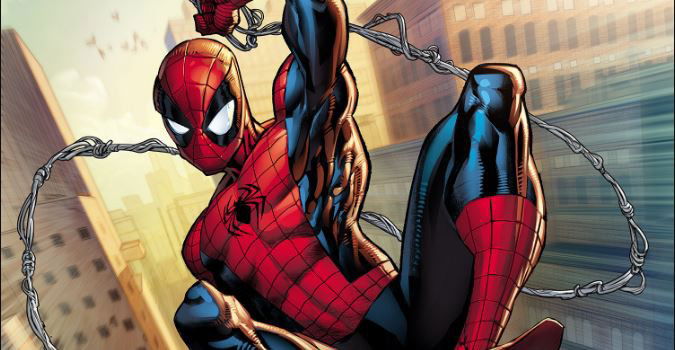

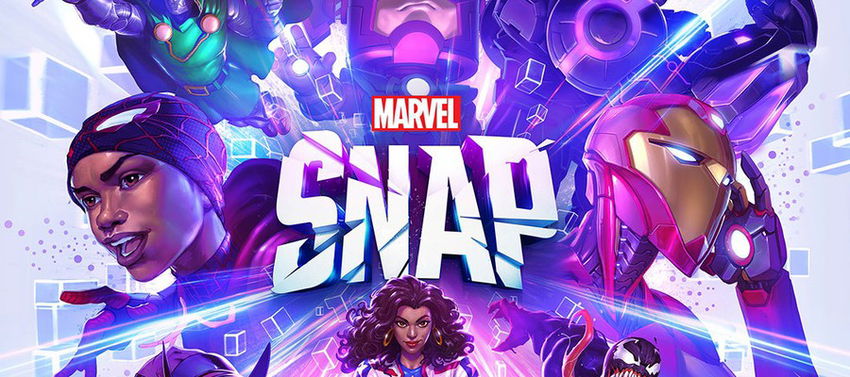







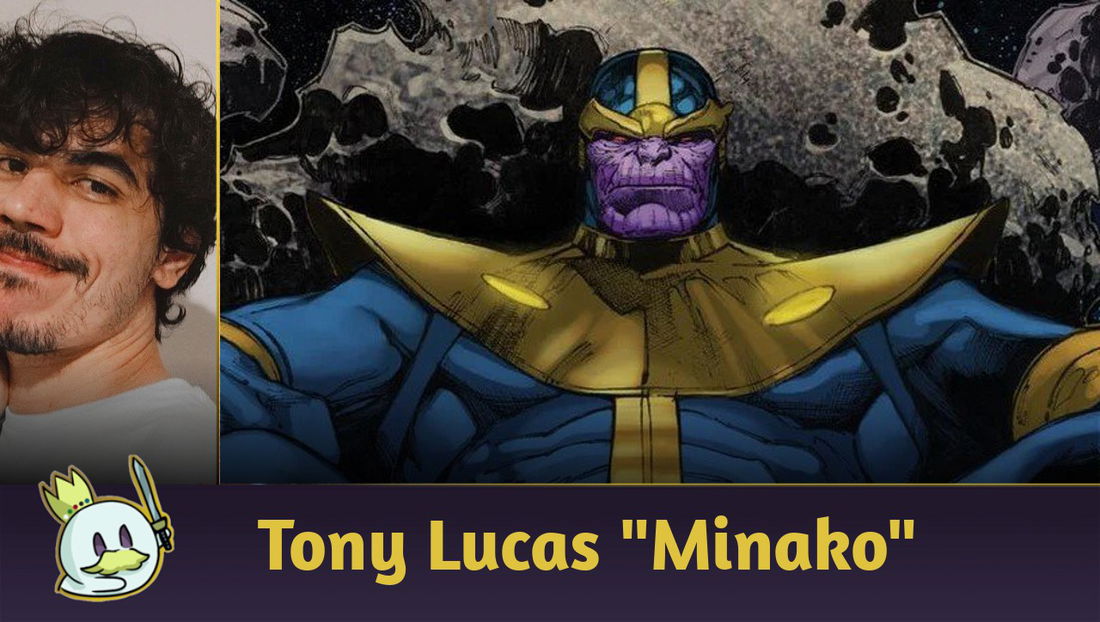
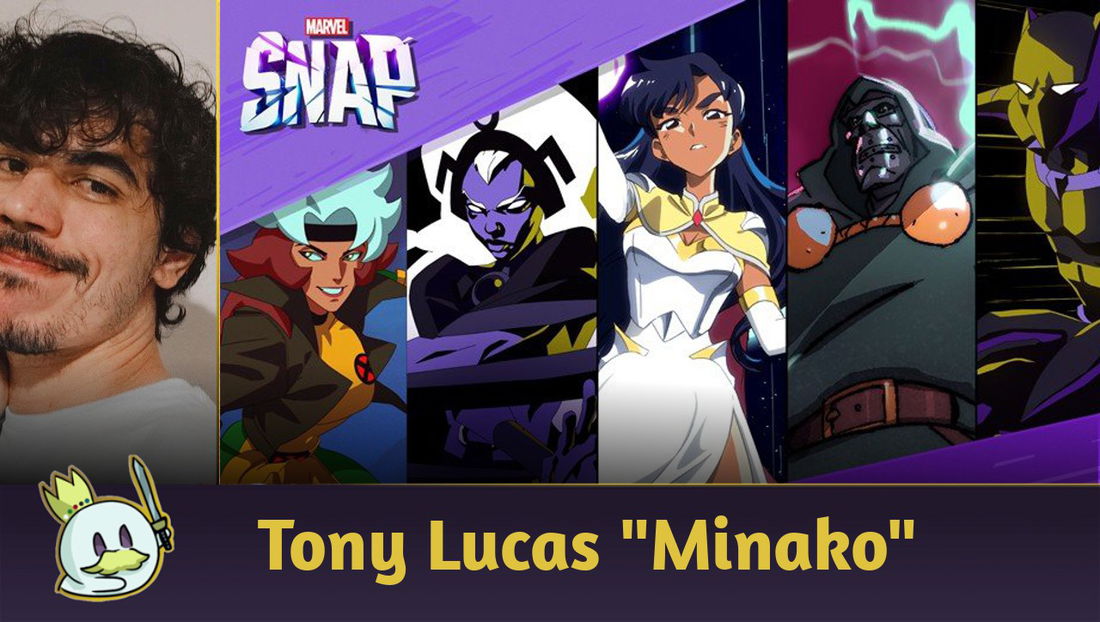



— Comentários 0
, Reações 1
Seja o primeiro a comentar